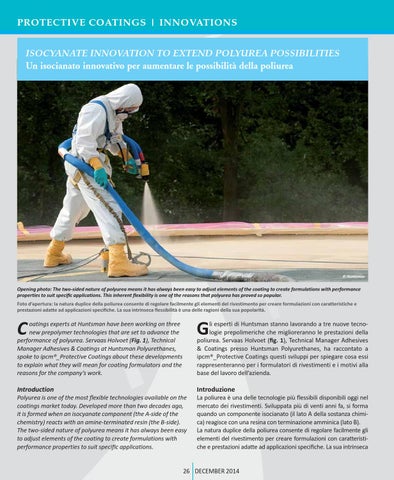PROTECTIVE COATINGS
INNOVATIONS
ISOCYANATE INNOVATION TO EXTEND POLYUREA POSSIBILITIES Un isocianato innovativo per aumentare le possibilità della poliurea
© Huntsman
Opening photo: The two-sided nature of polyurea means it has always been easy to adjust elements of the coating to create formulations with performance properties to suit specific applications. This inherent flexibility is one of the reasons that polyurea has proved so popular. Foto d’apertura: la natura duplice della poliurea consente di regolare facilmente gli elementi del rivestimento per creare formulazioni con caratteristiche e prestazioni adatte ad applicazioni specifiche. La sua intrinseca flessibilità è una delle ragioni della sua popolarità.
oatings experts at Huntsman have been working on three new prepolymer technologies that are set to advance the performance of polyurea. Servaas Holvoet (Fig. 1), Technical Manager Adhesives & Coatings at Huntsman Polyurethanes, spoke to ipcm®_Protective Coatings about these developments to explain what they will mean for coating formulators and the reasons for the company’s work.
C
li esperti di Huntsman stanno lavorando a tre nuove tecnologie prepolimeriche che miglioreranno le prestazioni della poliurea. Servaas Holvoet (fig. 1), Technical Manager Adhesives & Coatings presso Huntsman Polyurethanes, ha raccontato a ipcm®_Protective Coatings questi sviluppi per spiegare cosa essi rappresenteranno per i formulatori di rivestimenti e i motivi alla base del lavoro dell’azienda.
G
Introduction
Introduzione
Polyurea is one of the most flexible technologies available on the coatings market today. Developed more than two decades ago, it is formed when an isocyanate component (the A-side of the chemistry) reacts with an amine-terminated resin (the B-side). The two-sided nature of polyurea means it has always been easy to adjust elements of the coating to create formulations with performance properties to suit specific applications.
La poliurea è una delle tecnologie più flessibili disponibili oggi nel mercato dei rivestimenti. Sviluppata più di venti anni fa, si forma quando un componente isocianato (il lato A della sostanza chimica) reagisce con una resina con terminazione amminica (lato B). La natura duplice della poliurea consente di regolare facilmente gli elementi del rivestimento per creare formulazioni con caratteristiche e prestazioni adatte ad applicazioni specifiche. La sua intrinseca
26 DECEMBER 2014
